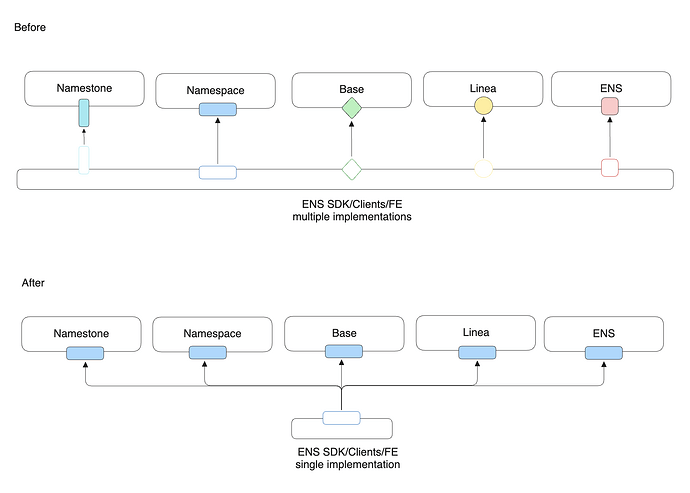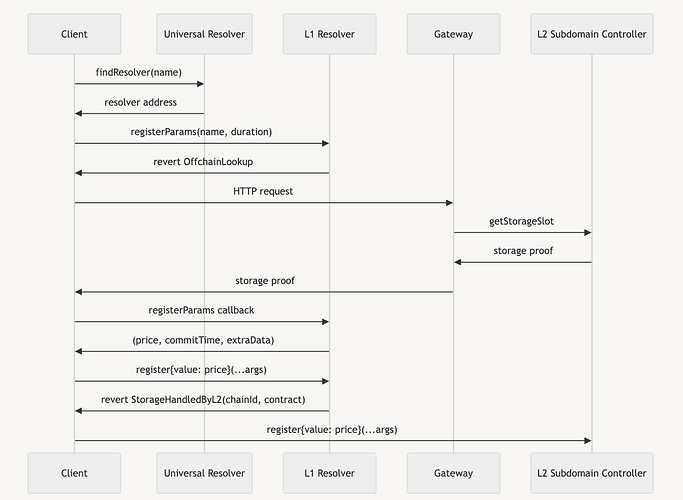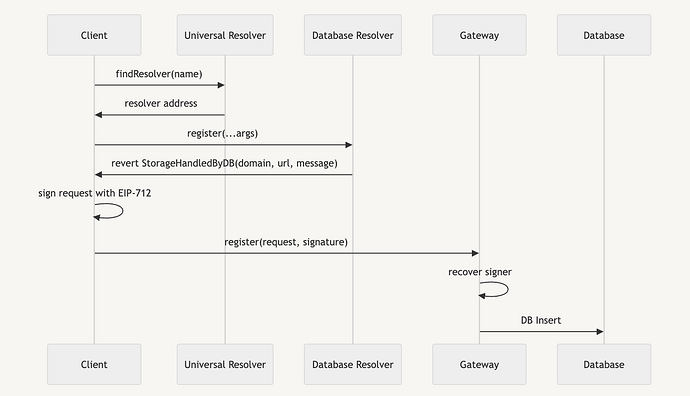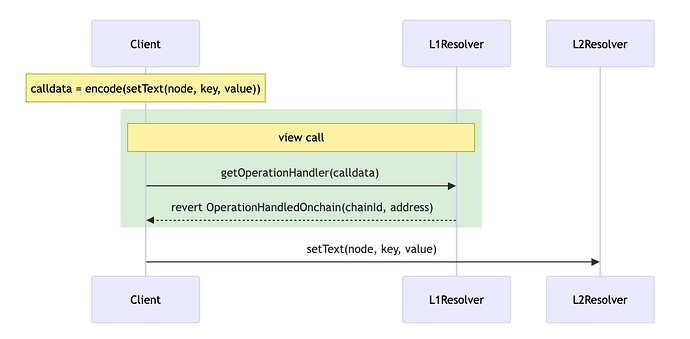A standard for write operations on off-chain domains.
Authors:
Abstract
This ENSIP proposes a standardized Off-chain Resolver interface for managing off-chain domains within the Ethereum Name Service (ENS) ecosystem. It addresses the growing trend of storing domains off the Ethereum blockchain to reduce transaction fees while maintaining compatibility with existing ENS components. The proposal outlines methods for domain registration, transferring, and setting records, ensuring a consistent approach to off-chain domain management.
Motivation
With the acceptance of CCIP-Read by the Ethereum community, there has been a notable shift towards storing domains in locations other than the Ethereum blockchain to avoid high transaction fees. This shift has revealed a significant gap: the lack of standardized methods for managing off-chain domains. By establishing a standardized off-chain resolver implementation and user flow, we can ensure a consistent approach to off-chain domain management, enabling applications that support this EIP flow to integrate this feature and enhance user experience seamlessly, increasing scalability and providing cost-effective solutions.
Specification
The standardization is made by using the Resolver that lives on Ethereum as an entry point for the off-chain calls. This means that the transactions for registering, transferring and managing a domain should first be made to the domain’s resolver that will be responsible for redirecting these calls to the respective destination.
Database Implementation Considerations
All supported offchain writing calls MUST rely on EIP-5559, specifying the custom error StorageHandledByOffChainDatabase. This error MUST return all required values to implement the EIP-712 signature, ensuring domain ownership.
L2 Implementation Considerations
Following EIP-5559, this specification MUST support implementation on L2 solutions. The specification describes the writing strategy for L2 relying on the custom error StorageHandledByL2 with the following arguments:
- Chain ID: the chain ID of the L2 network where the contract is deployed.
- Contract Address: the address of the contract on the L2 network.
Subdomain registering
Register parameters
As the initial step in registering an offchain subdomain, the registerParams function has been implemented to support a wide variety of use cases. This function plays a crucial role in creating a flexible and extensible offchain subdomain registration system.
Given that this step relies on the CCIP-Read standard, this interface SHALL only be implemented by the resolver deployed to Ethereum since it won’t be gathering the data through the function call on L2, but by directly accessing the storage layout of the given contract.
The function has the following signature:
function registerParams(
bytes calldata name,
uint256 duration
)
external
view
returns (uint256 price, uint256 commitTime, bytes extraData);
Parameters:
name: DNS-encoded name to be registeredduration: The duration in seconds for the registration
Return:
price: the amount of ETH charger per secondcommitTime: the amount of time the commit should wait before being revealedextraData: any given structure in an ABI encoded format
Since that CCIP-Read relies on storage direct access, the L2 contract is unable to run any function before sending the data. Therefore, any required logic MUST to be run on the function callback using the data gathered from the L2.
Sample of callback function used to validate and handle the response returned by the L2 contract:
function registerParamsCallback(
bytes[] memory values,
bytes memory extraData
)
public
pure
returns (uint256, uint256, bytes)
{
return abi.decode(values, (uint256, uint256, bytes));
}
The registerParams logic can be applied to the Database Domains where the pricing, commiting strategy or any other functionality SHOULD be handled by the Gateway.
Register subdomain
Aiming to integrate with the already existing interface of domain registration, the register function MUST have the following signature:
function register(
bytes calldata name,
address owner,
uint256 duration,
bytes32 secret,
address resolver,
bytes[] calldata data,
bool reverseRecord,
uint16 fuses,
bytes memory extraData
) external payable;
Parameters:
name: DNS-encoded name to be registeredowner: subdomain owner’s addressduration: the duration in miliseconds of the registrationsecret: random seed to be used for commit/revealresolver: the address of the resolver to set for this name.data: multicallable data bytes for setting records in the associated resolver upon registrationfuses: the nameWrapper fuses to set for this nameextraData: any additional data (e.g. signatures from an external source)
Behavior:
- When implemented by the resolver deployed to the Ethereum network it MUST revert with the respective error, providing necessary data for offchain processing.
- When implemented by the contract responsible for issuing subdomains on the given L2 or on the database it MUST register the subdomain.
- Both implementations should include appropriate access controls and emit events for transparency.
Transfer Domain
The interface for enabling domain transfers MUST be implemented by both the resolver deployed to Ethereum and the contract responsible for managing domains deployed on the L2 or the Gateway. The implementation differs as follows:
- L1 Resolver: MUST revert with the respective error described by EIP-5559, indicating that the actual transfer should occur elsewhere.
- L2 Contract or Gateway: MUST handle the actual domain transfer operation.
The transfer function MUST have the following signature:
function transfer(bytes32 node, address to) external;
With the arguments being:
node: a valid ENS node (namehash)to: the Ethereum address to receive the domain
Security Considerations
- The function SHOULD include appropriate access controls to ensure only authorized parties (e.g., the current owner) can initiate transfers.
- Implementations should consider emitting events to log transfer operations for transparency and offchain tracking.
Set records multicall
This function MUST be implemented to support batch operations on ENS records, providing a gas-efficient and convenient way to update multiple aspects of a domain or subdomain simultaneously.
The multicall function MUST have the following signature:
function multicall(bytes[] calldata data) external returns (bytes[] memory);
Parameters
data: An array of bytes, where each element represents an encoded function call.
Behavior:
- The L1 contract should use EIP-5559 to redirect the
multicalloperation to the appropriate offchain or L2 system by reverting with the entire transaction calldata. - The offchain or L2 implementation should process the batch operations and update the records accordingly.
- Events should be emitted to allow offchain indexers to track changes and maintain consistency with on-chain state.
Rationale
The proposed Offchain Resolver standardizes the management of offchain domains within the ENS ecosystem. By leveraging EIP-5559 for offchain writing and maintaining compatibility with existing ENS components, this proposal ensures a seamless integration of offchain domain management into current ENS workflows.
The use of reverts with custom errors allows for a consistent handling of offchain requests, while the implementation of standard ENS resolver functions ensures compatibility with existing ENS tools and interfaces.
Architecture
The proposed flow is designed to make the Resolver deployed on the L1 responsible for redirecting the requests to the given offchain storage, enabling the communication of any dapps (e.g. ENS dapp) in a standard way.
L2 subdomain registering
Database subdomain registering
Backwards Compatibility
This ENSIP introduces new functionality relying on an mechanism similar to what is being used on the CCIP-Read standard. However, it requires the EIP-5559 to change its behavior from having a intermediary structure to revert with the full msg.data provided by the client. This change is described on Appendix 1 and it’s being discussed in the following issue.
Reference Implementation
A reference implementation of the Offchain Resolver is provided in Appendix 1 and for the L2 Resolver in Appendix 2. These implementations include the core functions registerParams, register, transfer, and multicall, along with the necessary error handling for offchain storage.
Security Considerations
Database
- The authentication logic for domain ownership is shifted entirely to the signing step performed by the Client. Implementations MUST ensure robust signature verification to prevent unauthorized access or modifications.
- The Gateway that receives redirected calls is responsible for ownership validation. Proper security measures MUST be implemented in the Gateway to prevent unauthorized actions.
- The use of EIP-712 signatures for authentication provides a secure method for verifying domain ownership. However, implementers SHOULD be aware of potential signature replay attacks and implement appropriate mitigations.
- The offchain storage of domain information introduces potential risks related to data availability and integrity. Implementers SHOULD consider redundancy and data verification mechanisms to mitigate these risks.
- The
multicallfunction allows for batch operations, which could potentially be used for denial-of-service attacks if not properly rate-limited or gas-optimized. Implementations SHOULD include appropriate safeguards against such attacks.
L2
- L2 Security Model: Implementations on L2 MUST consider the security model of the chosen L2 solution. This includes understanding the dispute resolution mechanisms, data availability guarantees, and potential vulnerabilities specific to the L2 platform.
- Cross-layer Attacks: Implementers MUST be aware of potential attack vectors that could arise from cross-layer interactions. Proper validation and synchronization mechanisms SHOULD be implemented to prevent exploitation of differences between L1 and L2 states.
- L2 Exits: For L2 implementations, secure exit mechanisms MUST be provided to allow users to withdraw their domain ownership and data back to L1 in case of L2 failure or other emergencies.
- Data Availability Challenges: L2 implementations MUST have robust mechanisms to ensure that crucial ENS data remains available and verifiable on L1, even in scenarios where the L2 network faces challenges or downtime.
Further security analysis and auditing are RECOMMENDED before deploying this system in a production environment, with special attention given to the unique security considerations of both database and L2 implementations.
Appendix
Appendix 1: Offchain Storage Implementation with EIP-5559 changes
Although EIP-5559 is still under community discussion, it would be a huge improvement if the parameters were encoded as native bytes format, changing the parameters struct to the encoded calldata in bytes format and removing the type cast library from the contract. The StorageHandledByOffChainDatabase revert implementation as specified by EIP-5559:
// current IWriteDeferral implementation
struct messageData {
bytes4 functionSelector;
address sender;
parameter[] parameters;
uint256 expirationTimestamp;
}
// proposed IWriteDeferral implementation
struct messageData {
bytes callData; // encoded version of function signature and its arguments
address sender;
uint256 expirationTimestamp;
}
/**
* @notice Builds a StorageHandledByOffChainDatabase error.
* @param params The offChainDatabaseParamters used to build the corresponding mutation action.
*/
function _offChainStorage(IWriteDeferral.parameter[] memory params)
private
view
{
revert StorageHandledByOffChainDatabase(
IWriteDeferral.domainData({
name: _WRITE_DEFERRAL_DOMAIN_NAME,
version: _WRITE_DEFERRAL_DOMAIN_VERSION,
chainId: _CHAIN_ID,
verifyingContract: address(this)
}),
gatewayUrl,
IWriteDeferral.messageData({
callData: msg.data,
sender: msg.sender,
expirationTimestamp: block.timestamp
+ gatewayDatabaseTimeoutDuration
})
);
Appendix 2: L2 Resolver
contract L1Resolver is
IWriteDeferral,
OffchainRegister,
OffchainMulticallable,
OffchainRegisterParams
{
//////// CONTRACT IMMUTABLE STATE ////////
// id of chain that is storing the domains
uint256 immutable chainId;
//////// CONSTANTS ////////
/// Universal constant for the ETH coin type.
uint256 constant COIN_TYPE_ETH = 60;
uint256 constant RECORD_VERSIONS_SLOT = 0;
uint256 constant VERSIONABLE_ADDRESSES_SLOT = 2;
uint256 constant VERSIONABLE_HASHES_SLOT = 3;
uint256 constant VERSIONABLE_TEXTS_SLOT = 10;
uint256 constant PRICE_SLOT = 0;
uint256 constant COMMIT_SLOT = 1;
uint256 constant EXTRA_DATA_SLOT = 2;
/// Contract targets
address public target_resolver;
bytes32 public target_registrar;
//////// OFFCHAIN STORAGE REGISTER SUBDOMAIN ////////
/**
* Forwards the registering of a subdomain to the L2 contracts
* @param -name The DNS-encoded name to be registered.
* @param -owner Owner of the domain
* @param -duration duration The duration in seconds of the registration.
* @param -secret The secret to be used for the registration based on commit/reveal
* @param -resolver The address of the resolver to set for this name.
* @param -data Multicallable data bytes for setting records in the associated resolver upon reigstration.
* @param -reverseRecord Whether this name is the primary name
* @param -fuses The fuses to set for this name.
* @param -extraData any encoded additional data
*/
function register(
bytes calldata, /* name */
address, /* owner */
uint256, /* duration */
bytes32, /* secret */
address, /* resolver */
bytes[] calldata, /* data */
bool, /* reverseRecord */
uint16, /* fuses */
bytes memory /* extraData */
)
external
payable
{
_offChainStorage(target_registrar);
}
/**
* @notice Returns the registration parameters for a given name and duration
* @param -name The DNS-encoded name to query
* @param -duration The duration in seconds for the registration
* @return price The price of the registration in wei per second
* @return commitTime the amount of time the commit should wait before being revealed
* @return extraData any given structure in an ABI encoded format
*/
function registerParams(
bytes calldata, /* name */
uint256 /* duration */
)
external
view
override
returns (
uint256, /* price */
uint256, /* commitTime */
bytes memory /* extraData */
)
{
EVMFetcher.newFetchRequest(verifier, target_registrar).getStatic(
PRICE_SLOT
).getStatic(COMMIT_SLOT).fetch(this.registerParamsCallback.selector, "");
}
function registerParamsCallback(
bytes[] memory values,
bytes memory
)
public
pure
returns (uint256 price, uint256 commitTime, bytes memory extraData)
{
price = abi.decode(values[0], (uint256));
commitTime = abi.decode(values[1], (uint256));
return (price, commitTime, abi.encode(""));
}
/**
* @notice Executes multiple calls in a single transaction.
* @param -data An array of encoded function call data.
*/
function multicall(bytes[] calldata /* data */ )
external
view
override
returns (bytes[] memory)
{
_offChainStorage(target_resolver);
}
//////// ENS WRITE DEFERRAL RESOLVER (EIP-5559) ////////
/**
* @notice Builds an StorageHandledByL2 error.
*/
function _offChainStorage(address target) internal view {
revert StorageHandledByL2(chainId, target);
}
}
Appendix 3: CCIP-Store
Even though the recently proposed offchain writing strategy specified in EIP-7700 handles the signature step differently, the current register signature is still a fully compliant way of registering a new domain.
Appendix 4: IOffchainResolver interface
// SPDX-License-Identifier: MIT
pragma solidity ^0.8.17;
interface OffchainRegister {
/**
* Forwards the registering of a domain to the L2 contracts
* @param name The DNS-encoded name to be registered.
* @param owner Owner of the domain
* @param duration duration The duration in seconds of the registration.
* @param resolver The address of the resolver to set for this name.
* @param data Multicallable data bytes for setting records in the associated resolver upon reigstration.
* @param fuses The fuses to set for this name.
* @param extraData any encoded additional data
*/
function register(
bytes calldata name,
address owner,
uint256 duration,
bytes32 secret,
address resolver,
bytes[] calldata data,
bool reverseRecord,
uint16 fuses,
bytes memory extraData
)
external
payable;
}
interface OffchainRegisterParams {
/**
* @notice Returns the registration parameters for a given name and duration
* @param name The DNS-encoded name to query
* @param duration The duration in seconds for the registration
* @return price The price of the registration in wei per second
* @return commitTime the amount of time the commit should wait before being revealed
* @return extraData any given structure in an ABI encoded format
*/
function registerParams(
bytes memory name,
uint256 duration
)
external
view
returns (uint256 price, uint256 commitTime, bytes memory extraData);
}
interface OffchainMulticallable {
/**
* @notice Executes multiple calls in a single transaction.
* @param data An array of encoded function call data.
*/
function multicall(bytes[] calldata data)
external
returns (bytes[] memory);
}
interface OffchainCommitable {
/**
* @notice produces the commit hash from the register calldata
* @returns the hash of the commit to be used
*/
function makeCommitment(
string calldata name,
address owner,
uint256 duration,
bytes32 secret,
address resolver,
bytes[] calldata data,
bool reverseRecord,
uint16 fuses,
bytes memory extraData
) external pure returns (bytes32);
/**
* @notice Commits the register callData to prevent frontrunning.
* @param commitment hash of the register callData
*/
function commit(bytes32 commitment) external;
}
This work was developed by Blockful under the scope of the service provider stream.





